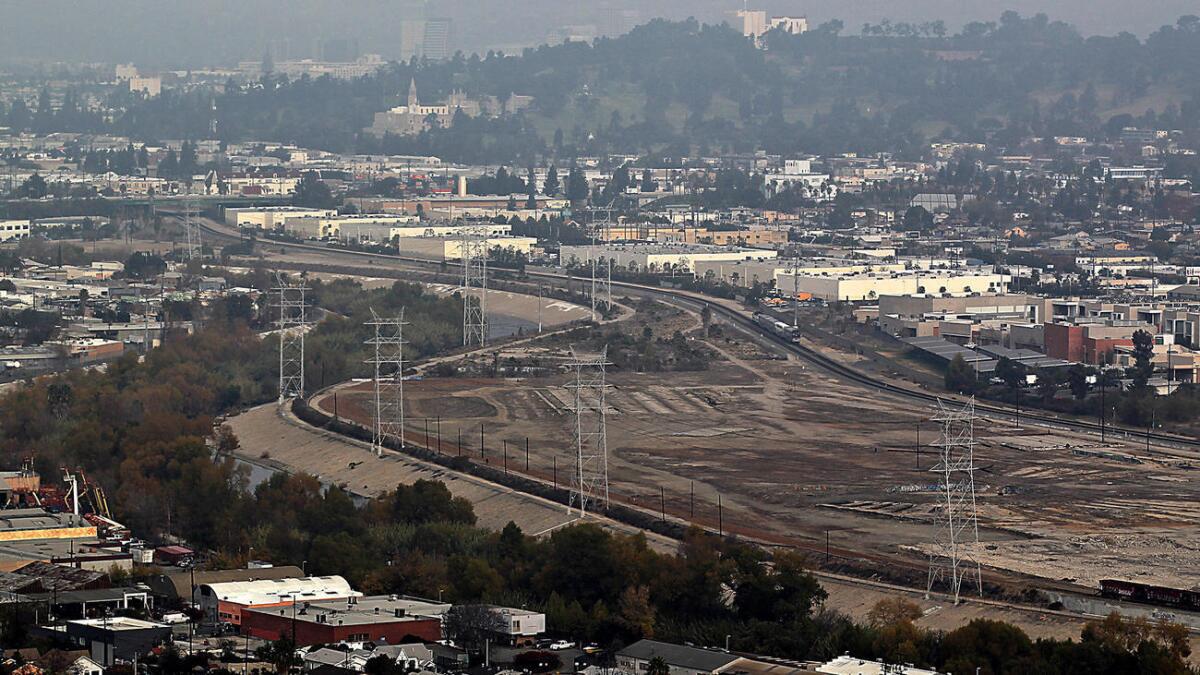We have one chance to save a crucial portion of the L.A. River. Let’s not blow it

- Share via
Thirty-two years ago, poet Lewis MacAdams, founder of Friends of the L.A. River, cut a hole in the chain link fence that blocked our collective access to the Los Angeles River. He was inspired by a vision of a re-wilded urban waterway brought back to life for the benefit of the city’s residents and its urban wildlife.
Three years ago, the city of Los Angeles and the U.S. Army Corps of Engineers took a big step toward that vision for a stretch of river between Griffith Park and downtown: rehabilitating 11 miles of riparian habitat, removing large swaths of the river’s concrete channel, maintaining flood mitigation with natural solutions, and sharing the cost, which is now estimated to be at least $1.4 billion.
Two years ago, the city advanced that plan when it purchased the G2 parcel at Taylor Yards, a former railroad industrial site on the river that, with Rio de Los Angeles State Park and the future Bowtie State Park, is intended to form a spectacular 100-acre, multiuse public riverfront for L.A.
In May, the city unveiled three design concepts for what it’s calling the Taylor Yard G2 River Park Project. Two of the concepts — dubbed “Soft Edge” and “Island” — are worth pursuing. The third, called “The Yards,” is a nonstarter. It would leave the straitjacketed river channel intact in an area that is particularly suited to be turned back into a natural river. It’s an unrivaled opportunity for re-wilding.Friends of the LA River is not alone in this vision. In less than two months nearly 2,000 community members have signed on to our Taylor Yard “Crack the Concrete” petition.
All three of the park designs are preliminary. Citizens, particular stakeholders, technical experts, the Army Corps and more will all have a say in how the design evolves, and the City Council will make the final choice. That’s years off. But we need to make ourselves heard about the future of the G2 parcel now because these designs are the basis of what’s to come.
From FoLAR’s perspective, the Soft Edge and Island proposals come closest to maximizing the site’s stellar potential. The Soft Edge concept suggests an intriguing approach to ecological restoration — concrete removal on the east bank, an emphasis on a varied stretch of wetland restoration, water treatment and stormwater pools, and lots of native plants. The Island proposal recreates wetlands and riparian habitat in a different way. It calls for construction of an island wildlife refuge within the river channel, accessible from both east and west banks of the river, along with concrete modifications on the east bank.
Both designs rightly prioritize public access to the river, with recreational amenities, space for exhibitions, amphitheaters, cafes and walking trails. FoLAR would prefer fewer structures (and therefore less added concrete), and as appealing as the designers’ renderings are, questions need to be answered about the hydrology of the proposed river channel modifications and the levels of habitat restoration that can be accomplished with each design.
We do have enough information to assess the final alternative, however. Even at this early stage in the process, it’s clear the Yards design would sorely disappoint all who’ve worked hard over the years for a restored river. It merely plunks down a park alongside the existing concrete channel, doubling down on decades of ecological neglect in Elysian Valley. It is most likely the least expensive of the alternatives, but it might also mean turning our backs on hundreds of millions of dollars in federal matching funds intended not for park construction but for river rehabilitation.
A lot is expected of the Taylor Yard project. As the city’s own chief design officer Christopher Hawthorne put it in this newspaper: “It would be tough to overstate either the potential or the complexity of this site. This is a habitat restoration project, an open-space equity project, a post-industrial remediation project and a hydrology project in an era of climate change.”
Amid all those ways of looking at the revitalization effort, we must not forget how it all began — with a desire to connect L.A. to a living river. We hope river lovers throughout Los Angeles will join us in continuing to press for a natural Los Angeles River running through the heart of the city. It may cost more and take more time, but it’s the best approach for Taylor Yard.
We have an unparalleled opportunity for a do-over at the G2 site, an effort that could set the standard for other similar urban reclamation projects. It has taken a generation of work to get this far. Let’s do it right.
Marissa Christiansen is the executive director of Friends of the L.A. River.
More to Read
A cure for the common opinion
Get thought-provoking perspectives with our weekly newsletter.
You may occasionally receive promotional content from the Los Angeles Times.






